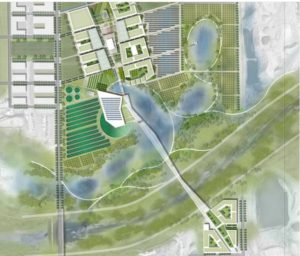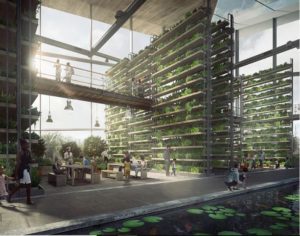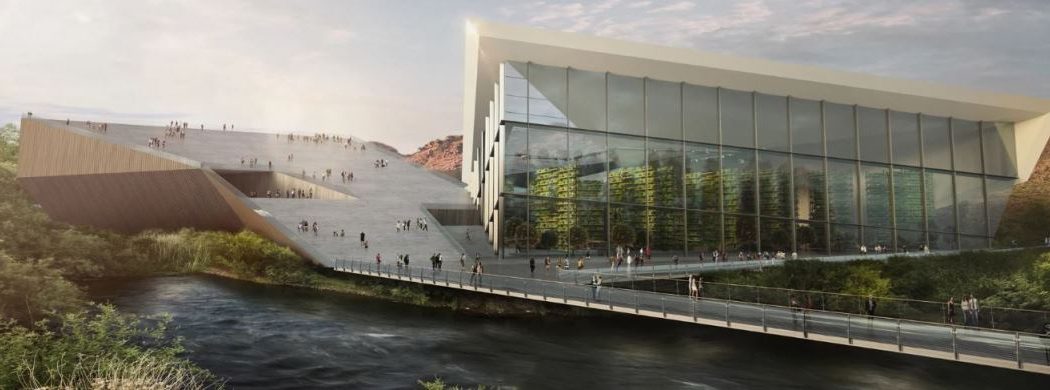In the June 15, 2018 issue of REVITALIZATION, we reported on an initiative to ecologically restore and economically revitalize a 58-mile stretch of the Rio Salado in Maricopa County, Arizona.
Now, Michael Krause of the Arizona-based architecture practice Krause has won that design competition, in collaboration with Kartika Rachmawati of the Brightview Design Group in Denver, Colorado with their design, called ECO2.
 ECO2 combines state-of-the-art sustainable technologies with regenerative landscape principals for the in-situ removal of soil contaminants to reconnect what will be a new vision for a resilient desert community.
ECO2 combines state-of-the-art sustainable technologies with regenerative landscape principals for the in-situ removal of soil contaminants to reconnect what will be a new vision for a resilient desert community.
As explained in my 2002 book, The Restoration Economy, in situ remediation techniques have the major advantage of not dumping tons of contaminated dirt elsewhere (Native American reservations are a traditional recipient), and of not burning vast quantities of fossil fuels to take them there.
The highly-toxic 19th Ave Superfund landfill site the project will mend the Rio Salado into an economic backbone for the region. ECO2 looks to tie together the lessons of past inhabitants to build an Arizona that embraces technological advancements and acknowledges the challenges of living in an environment on the bleeding edge of a warming climate where water and sustainable strategies are determining factors in development.
As contemporary cities and deserts grow, a common issue around the region is how to repurpose underutilized land / resources for urban development. ECO2 provides an insurance policy for the region while showcasing how urbanity and agriculture can be interwoven to enhance the relationship to people and the land.
ECO2 is 213 acres of self-sustaining buildings and landscape that are designed to encourage creative pursuits in the innovation of research and scientific advancement for agricultural products and processes in sustainable food technology, offering a high quality of living and integrated landscape systems that will weave into the fabric of the larger regional plan for Rio Salado.
The mixed-use, low-rise, high-density development will be the first modern community in the world to operate without fossil-fueled vehicles at street level. The development seeks to build an attractive pedestrian environment sheltered from the climatic extremes. With the surrounding land supporting it by harvesting Wind, Solar, Algae, and Urban Research Farming.
ECO2 is “urban acupuncture” for the intervention and restoration efforts that the Audubon and RISN have begun, seeking to become a completely green infrastructure for the Rio Salado west corridor. ECO2 will achieve this through a network of constructed ephemeral wetlands, hydrological ecosystems, native habitats, implementation of phytotechnology for landfill remediation and afforestation using native desert phreatophyte species to clean the groundwater and reduce urban heat island.
In addition, the planned conversion of the underutilized land into a productive and ecologically regenerative landscape using sustainable urban farming practices to include hydroponic and aquaponic technologies. ECO2 provides a regional example of repairing landfill into an economically beneficial and thriving community.
 At the heart of which is GrowHaus 2.0 an education and neighborhood resource center for the advancement of new ideas and to produce agriculture in extreme environments. The place making building will strengthen the development and surrounding communities providing a bespoke link to future ideas along the Rio.
At the heart of which is GrowHaus 2.0 an education and neighborhood resource center for the advancement of new ideas and to produce agriculture in extreme environments. The place making building will strengthen the development and surrounding communities providing a bespoke link to future ideas along the Rio.
A robust public realm is planned for the green spine that runs through the development celebrating agriculture as a key component of its urban growth. What we aspire to represent showcases a Holistic Net Positive approach to create a mixed-use, dynamic, active environment that is far removed from the sprawling Phoenix that we see today.
A new type of development is created on what is the environmental edge of increasing temperatures and water shortages. It is imperative that future growth consider food and water security as a priority. The plan for ECO2 offers an approach which shows that agriculture can coexist with development, that sustainability can be timeless, that water can be re-used and harvested, that it’s hot and getting hotter and the space between buildings belongs to the pedestrian…not the automobile.
All images courtesy of Krause.

